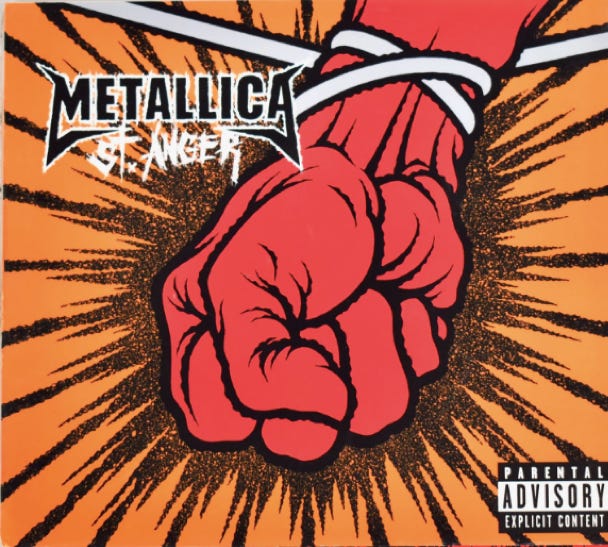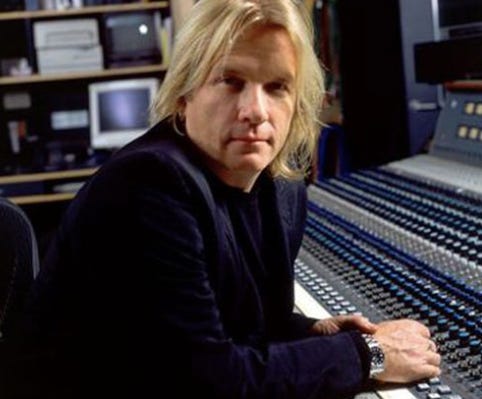ALBUM REVIEW: Trelldom - ...By The Shadows...
...By The Shadows... will be released September 13th on Prophecy Productions Trelldom is a truly underrated black metal band that

I regret to inform you all that I had a very unfortunate experience about a week ago.
I listened to Metallica’s 2003 release, St. Anger, in full for the first time in years.

St. Anger is widely regarded not just as Metallica’s worst album, but as one of the worst albums to ever be recorded since the phonograph was invented. It is a punchline in the world of rock and metal. To make it through all 75 minutes in one sitting should be classified as a form of masochism. There are a litany of issues with the album that if you are familiar with its contents, should be no surprise to you: the production, Lars’ snare drum sounding like he’s banging on a trash can, the song lengths, James' out-of-key vocals, down-tuned guitars, no solos, awful lyrics, and some truly pathetic moments that will make you cringe. Oh, and their producer played bass. By the third song, you’ll forget that this same band ever wrote …and Justice for All and beg for mercy.
If you’ve never listened to it, consider yourself one of the lucky ones who made it through the early 2000s unscathed. Unluckily for you, however, I’ve prepared a brief synopsis of the lowlights of all 11 atrocious tracks that in sum create the worst album, perhaps of all time.
Please keep in mind that these are the absolute worst moments of the album. I tried to keep this section as short as possible. If you really want to get the full St. Anger experience, you need to listen to the entire album. Far better writers have tried to explain it using only words and have failed. You’ll hate yourself afterwards, but the only true way to experience its awfulness is sonically (apologies to your ears).
Or if you prefer the Cliff’s Notes, try the two-minute summary of the album provided below:
By all accounts, the release of St. Anger is the absolute low point of Metallica’s career. It makes Load and Reload look like Ride the Lightning and Master of Puppets. When you think about how many people are involved in making a record, and the care Metallica had taken to this point to safeguard their legacy and image, as they still do today, one has to wonder: how the hell did this thing get greenlighted to be released? Who had the power to stop this audio monstrosity from being produced and didn’t? Who thought this would be a good idea? Inspired by “Dirty Window,” I’ll be playing the role of judge and jury in the case of We the People vs. St. Anger as we explore who deserves the most blame for it.

Kirk tried his best to keep it real. The dude used to play in Exodus before he joined Metallica. He’s been shredding since Jimmy Carter was the President. The guitar solo belongs in metal songs. If you watch the clip above, Kirk expresses concern that the band is not really being authentic if they exclude guitar solos just to be part of a trend. The trend he’s referring to is the nu-metal trend, which the band had seemingly delved into at this point at least partially with their approach to St. Anger. His point that it dates the music is accurate. This is actually the most upset I’ve ever seen Kirk, who seems passive at best in the Metallica dynamic, which is understandable given the personalities of James and Lars. I’d imagine he was not on board for a lot of what was going on, but was pretty helpless to stop it.
VERDICT: Not guilty, but guilty by association.

Newsted quit Metallica in 2001 after James Hetfield checked into rehab. He cited personal and health reasons, which were legitimate. Jason had sustained permanent damage to his neck and back, literally from headbanging while on tour with the band. In fact, a doctor told him he needed to stop nearly ten years prior to his departure, but he ignored him. Hetfield had also blocked Newsted from working and touring with his side project, Echobrain. The concern was that no other members of Metallica had side projects and the band was to be their sole focus, so as not to breed any competition with the main brand. Newsted, upset that his other band could never threaten Metallica (and they never did), quit the biggest metal group in the world. Having previously played in Flotsam and Jetsam, and ending up in Voivod later in his career, I have a feeling Jason would have been pretty vocal about the direction the band was taking. He was and is your standard metalhead. If he hadn’t quit in 2001, the sessions for St. Anger would have surely put him over the edge. He can’t be blamed for St. Anger because he wasn’t a part of the recording sessions, but his departure from the band surely was another domino falling that led to this abomination being recorded.
VERDICT: Not guilty, but surely feeling some guilt.

Here’s a name you might be surprised to see on the docket – but I assure you he’s partially to blame for this. Fred and Limp Bizkit were at the forefront of nu metal, which exploded in the late 90s and early 2000s as the public’s new preferred way to rock. Down-tuned guitars, angry and basic lyrics, and nearly no guitar solos – sounds familiar! This was the trendiness Kirk was wary of in his clip above. But it runs deeper than that – to Metallica’s last release prior to St. Anger.
In 2000, it was announced that Metallica would be providing the main song for the soundtrack to Mission: Impossible 2, which was a big deal at the time, as movie soundtracks with exclusive tracks were still en vogue. They wrote and recorded “I Disappear” for the soundtrack, which is a fine song but not their best. Apparently the producers weren’t happy with the track as the lead, so they replaced it with Limp Bizkit’s offering, “Take a Look Around.” Is it possible that this is when Metallica started to reconsider their sound to cater to what was popular? Consider who their support band was in 2003 when they hit the road in support of St. Anger: none other than Fred Durst and Limp Bizkit.
VERDICT: Guilty, aiding and abetting a band’s downfall on two counts. Woodstock ’99 will be tried separately.

Admittedly, Hetfield was going through a lot during the time of these recordings. He had entered rehab in 2001 for various addictions including alcoholism. He eventually rejoined the band in the studio in 2002 to resume recording. Over the next year, he was only allowed to work on the album between the hours of noon to 4:00pm, which considerably lengthened the process for the band. It also created tension between the band, which is captured in the documentary “Some Kind of Monster.” As the main songwriter, Hetfield bares much of the responsibility for the atrocious lyrics on the album, which really seem to serve as some kind of therapy for a man going through a lot personally. Though the results are trash, I do have some sympathy for Het in this case, as he clearly had many different issues to work through while trying to save his band.
VERDICT: Guilty, eleven counts of slandering his own band’s good name under duress
I’d like to present excerpts from a Rolling Stone review of St. Anger that was published two days prior to the album’s release as evidence against the music media:
No wonder there’s an authenticity to St. Anger‘s fury that none of the band’s rap-metal followers can touch. Across seventy-five-plus minutes of savage but intricate structures that recall those pre-Black glory days, Metallica go back to their brutal essence. There’s no radio-size, four-minute rock here, no pop-friendly choruses, no ballads, no solos, no wayward experimentation. Recorded with longtime producer Bob Rock on bass, this is loud, expansive, unrepentant Metallica.
Although it was written and recorded in the studio, St. Anger barely resembles a studio album. The raw sounds on the throttling opening cut, “Frantic,” are essentially the same raw sounds that are heard throughout the next ten tracks, as if the band members focused solely on playing off one another, not the mixing board, and were too busy to notice that the snare drum annoyingly goes ping instead of snap. Rock’s bass is mixed way down in a blare of guitar-and-drums midrange that recalls 1988’s . . . And Justice for All — over him, the band hammers out its signature staccato stops-and-starts and multiple tempo and key changes like three angry fingers on the same fist. It’s a rush to be pummeled by this group again.
Despite the songwriting help from drummer Lars Ulrich and guitarist Kirk Hammett, St. Anger chronicles Hetfield coping with recovery’s ugly truths. He’s still ornery, still defensive and still sometimes overselling his rage. On the final track, “All Within My Hands,” he sings, “Love is control/I’ll die if I let go,” and the album ends with him screaming, “Kill! Kill! Kill!” seemingly unable to forgive himself or others as sobriety demands, stuck in the same dark childhood place he’s always struggled to escape. It’s a closing that puts an uneasy spin on the album’s return-to-basics approach and makes it seem more of a masterful retreat than a fully victorious breakthrough into new territory.
If there’s no one to tell you your new album sucks, who’s to stop you from releasing it and making asses of yourselves?
VERDICT: Guilty, one count of fraud and one count of reckless endangerment.

With James in a fragile state and Kirk being meek, Lars has to bear the brunt of the blame for St. Anger. The band’s reputation had taken a large hit with their lawsuit against Napster, tarnishing their public image. For a band that basically made themselves through underground bootlegs, it was a very tone deaf move to personally go after fans who had downloaded music illegally. Lars was at the forefront of that effort, and the internet lambasted him for doing so. If anyone stood anything to gain from a new Metallica record, it was him. He was also very adamant about having no solos on the album, and is generally the most miserable guy in Metallica in every scenario. It’s no secret that everything the band okays usually has Lars’ blessing. This sentiment comes across in the documentary as well. From a business standpoint, I think he wanted to capitalize on the current trend in music and maybe recapture some of the good PR the band had lost in recent years. He failed on both counts.
VERDICT: Guilty, one count illegally downloading other bands’ style and one count petty larceny for stealing a garbage can to use as a snare drum.
If you were responsible for safeguarding Metallica’s brand, wouldn’t you have taken steps to protect the carefully crafted image you’d created for them over the past 20 years? The lead singer and songwriter for the band had just exited rehab. The drummer had just sued his own fans. The bassist quit over a dispute with your management company and said lead singer and songwriter. One might think the best approach would be to resolve all these issues in private and work on getting some positive news out for the group. What did Q Prime do? On top of allowing the band to continue recording this sonic abomination they were working on, they signed the band up for a documentary that showed a looking in view to the band essentially falling apart.
“Some Kind of Monster” shows the creative process, if you want to call it that, of the making of St. Anger. When they were disheartened by the progress on the album, Q Prime hired a “performance enhancement coach” to come in and essentially counsel the band through their bickering in order to get the album produced. The results are ugly on both ends. The album stinks and the band came off looking worse than they ever have. I’ll give Metallica respect for being brazen enough to bear their faults for all to see, but the management company is supposed to look out for their clients’ image, not just their bank accounts.
VERDICT: Guilty, three counts of defamation.

Bob Rock is the producer of St. Anger. He also played bass and was essentially the 4th member of Metallica for it’s making, so he was heavily involved in creating the music. He had formerly produced albums for the band, most notably The Black Album, which was a major commercial success but also had fans decrying the band as sellouts. He produced all of their subsequent albums to this point, as well as major acts like Bon Jovi, Skid Row, Mötley Crüe, and David Lee Roth.
I’d like to introduce the following quotes from Bob Rock as evidence:
I wanted to do something to shake up radio and the way everything else sounds. To me, this album sounds like four guys in a garage getting together and writing rock songs.
We made a promise to ourselves that we'd only keep stuff that had integrity. We didn't want to make a theatrical statement by adding overdubs. If we added something and it helped the mood or what we were trying to convey, that stayed. But if it distracted from that, then we killed it. Every time we tried to do a solo, either it dated [the sound of the music] slightly or took away from what we were trying to accomplish in some other way. I think we wanted all the aggression to come from the band rather than one player.
There are movements in movie-making and in music where you take technology as an art and you actually abuse it. Some people use ProTools to trick and fool the listener, but we used it more as a creative tool to do something interesting and stretch boundaries. Technically, you'll hear cymbals go away and you'll hear bad edits. We wanted to disregard what everybody assumes records should be and throw out all the rules. I've spent 25 years learning how to do it the so-called right way. I didn't want to do that anymore.
Suffice it to say, Bob was certainly successful in his goals. He made an album that sounded like shit on purpose, and was surprised when mostly everyone hated it and nobody wanted to play it. To use the word integrity to describe the tracks on St. Anger makes me think he has a very tenuous grasp on the English language. It’s funny – he’s gone on to produce albums for many different popular bands since St. Anger and not one of them sounds like what he’s describing here. Maybe the lesson to be learned here is that it’s usually better to just make albums the right way, Bob.
VERDICT: Guilty, three counts of attempted first degree murder.
Twenty plus years after its release, there’s still plenty of blame to be spread around for the train-wreck that is St. Anger. The band members, past and present, all had their fingerprints on it in one way or another. Whether it was by departure, poor headspace, lack of a backbone, or trying to capitalize on the day’s music trend, they all played some significant role in the domino effect that led to its creation. Metallica’s management exploited the band, no doubt with the band on board, when they both saw more dollar signs flashing in their eyes. Music critics praised the album blindly prior to its release. Their own producer sabotaged the project with a new vision of what an album should be that crashed and burned spectacularly. St. Anger is a cautionary tale for any band that thinks they’re too big to fail. The wrong combination of events and yes men led even the biggest metal band in the world to an absolutely pathetic low that they’ve only recovered from recently.
And to think, this could have all been avoided if they had just listened to Lars’ dad:
What happened on this day in #ROCK #CLASSICROCK #GLAMMETAL #HEAVYMETAL #THRASH history! #TDIM